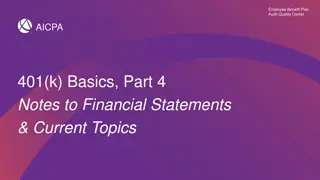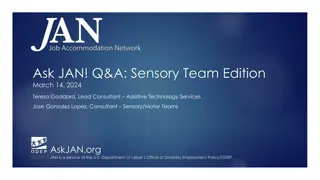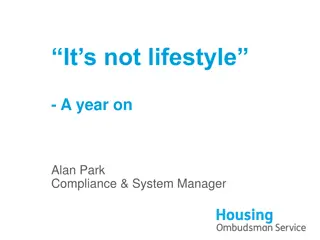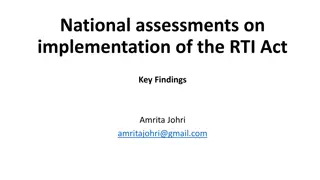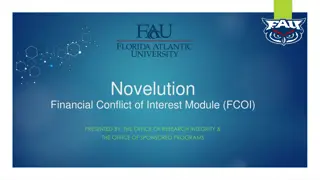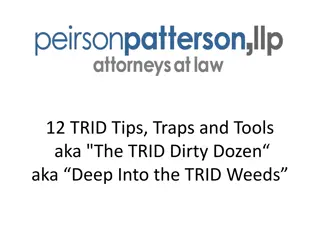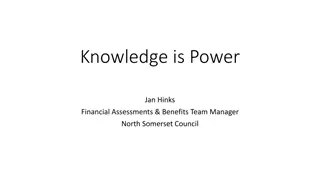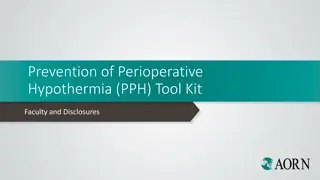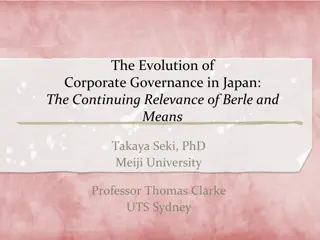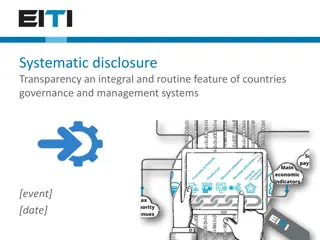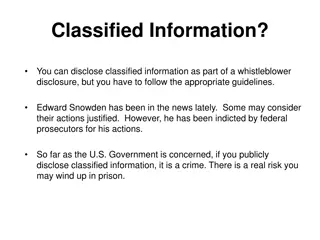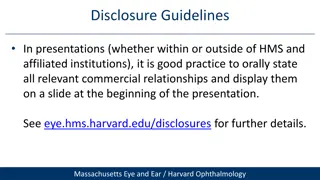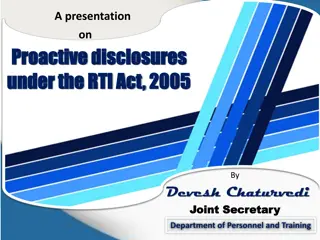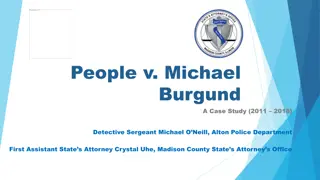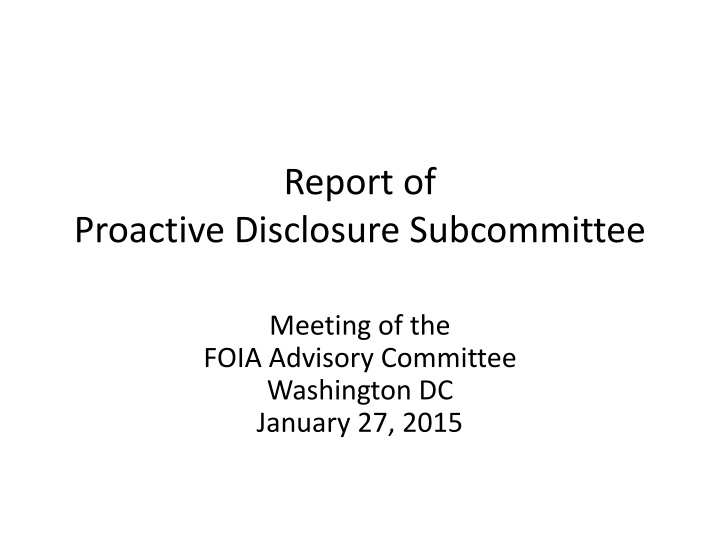
Proactive Disclosure Subcommittee Meeting Report
This report highlights the discussions and progress made during the Proactive Disclosure Subcommittee Meeting of the FOIA Advisory Committee held on January 27, 2015 in Washington, DC. The meeting covered topics such as analyzing FOIA requests for high-value records and reconciling proactive disclosure with Section 508 accessibility requirements. Key points include insights from studies by organizations like Reinvent Albany and the General Services Administration on gathering data about external use of government information. Additionally, the report emphasizes the importance of finding meaningful information in FOIA request logs and provides examples from the Environmental Protection Agency (EPA).
Download Presentation

Please find below an Image/Link to download the presentation.
The content on the website is provided AS IS for your information and personal use only. It may not be sold, licensed, or shared on other websites without obtaining consent from the author. If you encounter any issues during the download, it is possible that the publisher has removed the file from their server.
You are allowed to download the files provided on this website for personal or commercial use, subject to the condition that they are used lawfully. All files are the property of their respective owners.
The content on the website is provided AS IS for your information and personal use only. It may not be sold, licensed, or shared on other websites without obtaining consent from the author.
E N D
Presentation Transcript
Report of Proactive Disclosure Subcommittee Meeting of the FOIA Advisory Committee Washington DC January 27, 2015
We are working on two topics I. Analyzing FOIA requests to identify high- value types of records for proactive disclosure. II. Reconciling proactive disclosure with accessibility under Section 508.
I. Analyzing FOIA requests to identify high-value types of records for proactive disclosure.
Follow-up on Reinvent Albany Study We interviewed Reinvent Albany by phone to ask about their methodology. They used FOIA logs to identify most frequent requestors, then contacted requestors to ask what type of records they usually requested.
Similar Study by General Services Administration To gather information for OMB data call about external use of government data GSA FOIA office identified regular requestors or repetitive requestors GSA surveyed the identified requestors. Citation: Myehsha Boone, Who s Using Your Agency s Data? , Dec. 19, 2014 on DigitalGov.gov
Finding Information on Content of FOIA Requests FOIA logs: Several agencies on FOIAonline.gov Some other agencies on agency web sites Some agencies do not post logs, but might be obtainable through FOIA Agencies vary in whether most log entries have meaningful description of information requested At least one agency has copies of FOIA requests available on its web site.
EPA: Source Material Source: https://foiaonline.regulations.gov Example of the Good: https://foiaonline.regulations.gov/foia/action/public/view/request?objectId=0900 04d2801654eb Example of the Bad: https://foiaonline.regulations.gov/foia/action/public/view/request?objectId=0900 04d280014d04 The description of this request is under Agency review. (Request closed in 2012.) There were 4,654 available requests submitted between January 1, 2008 and December 1, 2014 Of those 4,654 submitted requests, 3,864 had a publicly available body text (an average of 1.5 requests per day)
EPA: Primary Categories Substance Inventories, CFAs, Citations, Claims, Determinations, HED Documents, Impact Statements
EPA: Primary Entities Anaconda Smelter, Archer Daniels Midland, Diamond Alkali, Burgess Niple, Delta Thermo, Dupon Nemours, Kaiser Gypsum, Shine Bros, .
EPA: Compounds and Chemicals Polychlorinated biphenyls, Mercury Polycyclic, Ionizing Radiation, Radon, Magnanese Mercury, Emamectin Benzoate
EPA: Word Density and Proximity Environmental property storage hazardous tanks information permits violations block spills underground lot regarding avenue releases pertaining requesting waste new files Site superfund id located river county cerclis assessment groundwater remediation corporation texas san investigation phase illinois creek contamination jacinto nj Water quality management air supply waste solid community records program manifests ust tank cleanup health pa owner clean underground storage Documents including reports related correspondence records relating limited asbestos present concerning notes investigation requesting agency inspection orders new january remediation
EPA: Word Density and Proximity Environmental property storage hazardous tanks information permits violations block spills underground lot regarding avenue releases pertaining requesting waste new files Site superfund id located river county cerclis assessment groundwater remediation corporation texas san investigation phase illinois creek contamination jacinto nj Water quality management air supply waste solid community records program manifests ust tank cleanup health pa owner clean underground storage Documents including reports related correspondence records relating limited asbestos present concerning notes investigation requesting agency inspection orders new january remediation
Requested Support from Committee Member(s) The Proactive Disclosure Subcommittee would like to take this base case and extend it with a much larger dataset. We believe we can identify key categories of documents, requests and requestors in order to make concrete recommendations about where to optimally begin with Proactive Disclosure in order to have the largest impact with the least effort. Will a member(s) step up an volunteer to shepherd us through within their agency, to explore a more robust dataset?
II. Reconciling proactive disclosure with accessibility under Section 508.
Some Requirement of Section 508 Federal information technology must ensure "individuals with disabilities...have access to and use of information and data that is comparable to [persons without disabilities]. If making technology accessible would be undue burden on agency, then agency must provide alternative means of access that allows the individual to use the information and data. United States Access Board standards define technical and functional performance criteria for satisfying Section 508.
Most records should already be in accessible formats. Section 508 also requires comparable access for Federal employees who have disabilities. So records should already be in accessible format, even if agency hasn t been making the records public. (For example, word processing documents that software can read out loud.)
But some records present problems: Records from paper-based workflows. Graphics that have not been tagged with alternative text. Usual methods of redacting accessible documents make them inaccessible. Records can be remediated to make them accessible, but takes some work. e.g., Dept. of Homeland Security memo on Creating 508-Compliant PDF Documents , June 14, 2010.
Straw Man Proposal: What are real cases where this doesn t work? Apply the same standards to proactively disclosed records as to any other publicly-available information: Post records in accessible form, unless agency determines undue burden . If undue burden , then provide alternative means of access , for example, selected records converted to accessible form on request. Do not delay proactive disclosure while records are made accessible. Disclose while proceeding to remediate accessibility.

